How to harden your employees from the massive social engineering threat
Social engineering is the art of human deception. In the world of cybersecurity, it’s how to fool human beings in order to conduct cyber attacks. Some of these cyber attacks can be very expensive to your business! In fact, many of the worst cyber attacks to your organization’s network start with fooling you or one of your employees. Penetrating a network without human interaction is really tough.





